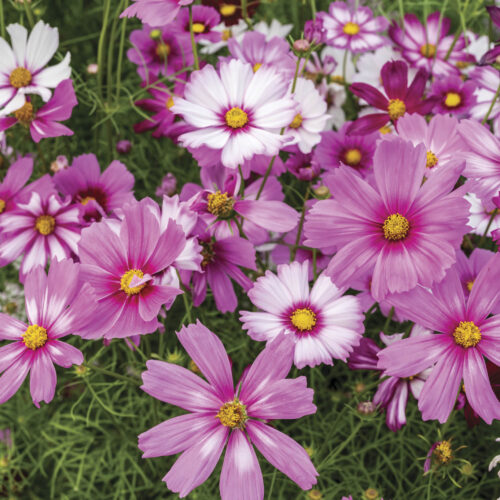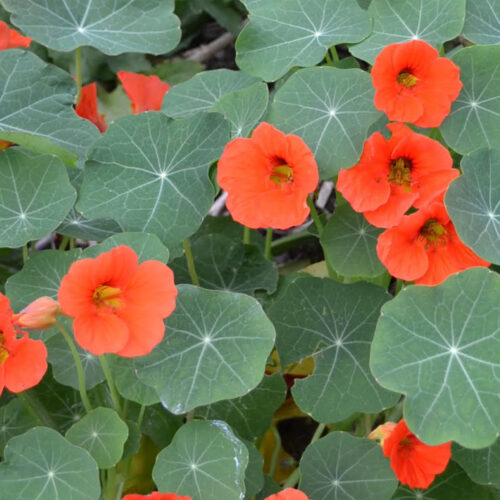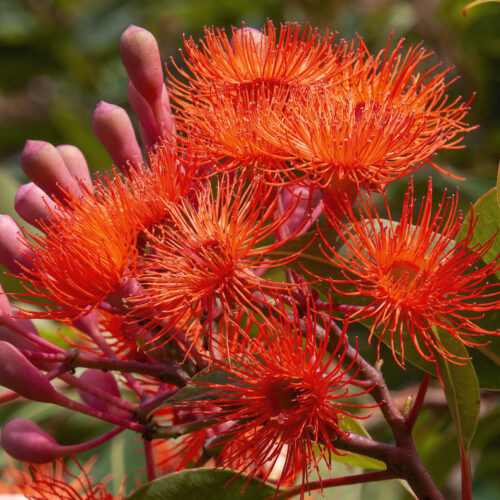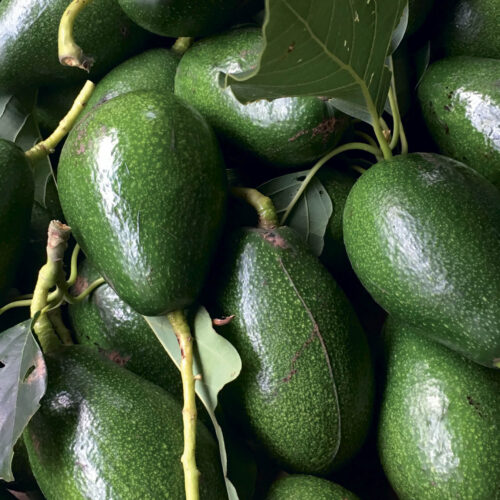Bamboo beauties
2009-12-22T02:40:22+11:00
Beautiful and useful, non-invasive clumping bamboos can be a wonderful asset in the garden. NICK ROMANOWSKI chooses some of the most distinctive for tropical and temperate climates.
Big and beautiful, bamboos have been an inspiration to artists, poets and gardeners for centuries. They are among the most distinctive and elegant of plants, and even though their flowers are barely noticeable, bamboos are among those few archetypes, such as roses, waterlilies and orchids, which even non-gardeners recognise at a glance. Standing in a tall bamboo grove the world seems reduced to basics, with the soft hiss of the breeze through the leaves and sunlight through patterns of cane.
For all their often-impressive size, bamboos are actually primitive grasses, mostly from the tropical to warm-temperate zones of Asia and the Americas, though there are a few groups that have made their way north and south into much colder climates. A few tropical species have reached northern Australia from Asia and evolved into distinctive native forms, such as the water-loving Bambusa arnhemica, though none of these have adapted to subtropical areas as yet.
Growth habits
There are a number of systems of classifying the growth habits of bamboos, the simplest of which is clumping (sympodial) versus running (leptomorph) types. It isn’t always obvious which is which, as some clumping bamboos grow in a diffuse way so their culms (also called canes) are widely spaced. Similarly, there are a few running types which creep very slowly.
Although there are many useful running bamboos, we are concentrating on clumpers, which are by far the more manageable species. These can be reliably selected according to known growth patterns, eventual height, whether they sprawl or stand straight up, and how much area they are likely to take up with time. With hundreds of species and varieties to choose from, the short lists in this article are just a selection of some of the most distinctive and interesting types for both tropical and temperate climates.
Identification of the many bamboo species and their forms is a specialised business. To be safe, you should ask for particular varieties by their botanical name. Common names may be applied to more than one species, or misapplied by general nurseries, so the most reliable sources for most of the varieties described below are specialist bamboo nurseries.
Growing bamboo
Bamboos are generally pest- and disease-free, but they are greedy feeders and need a reliable source of water for good growth. If you’re growing a bamboo in a pot and don’t want to multiply it in a hurry, a heavy initial fertilisation with nitrogen-rich compost or blood-and-bone will encourage it to fill the pot rapidly, and then as the fertiliser runs out, plant growth will slow down over a year or two. Slight stress caused by a shortage of nutrients may bring out stronger colours in the canes, but if the leaves start to look yellowish, you’ve overdone the stressing and should add a moderate amount of fertiliser immediately and water it in well.
The same fertiliser regime applies to plants in the ground if you want to keep a brake on their growth over time. However, to get a bamboo screen up quickly, keep the water up during hot weather; a reasonable soaking once a month may be all that is needed. For vigorous growth, fertilise in winter to spring (depending on species), well ahead of each new season’s crop of young shoots. This gives the plant time to absorb and process the nutrients needed. Larger-growing bamboos will thrive on run-off from septic tanks or even grey water in moderate amounts, as long as you are only using soaps suitable for direct use on the garden.
Frost tolerance
One of the most misleading aspects of bamboo cultivation, particularly for clumping species, is frost tolerance. This is usually given as a precise figure, suggesting that if it doesn’t get colder than that in your area, a particular bamboo will grow without problems. However, most clumping bamboos are tropical to warm temperate in origin, and the fact that they may survive a single cold snap of this degree doesn’t mean they will thrive, especially in areas with a consistently cold climate between frosts.
Most bamboos which have been known to survive -2°C or -3°C, however marginally, are usually set back considerably by the experience. Even those which aren’t quite so frost-sensitive rarely reach anywhere near their maximum size in southern states. Conversely, many clumping bamboos that tolerate considerable degrees of frost are from sub-alpine areas or other consistently cool to cold areas, and grow poorly in areas with a hot or dry summer.
Propagation
Many bamboos rarely flower or set seed, so propagation is usually by division, and this is the only way to multiply all named varieties. Smaller bamboos already well-established in pots are easily divided by hand, teasing the canes apart to form two or three well-defined clumps, and then firmly pulling them apart. If the underground stems look too thick to separate easily without tearing, use a heavy blade or an old pair of secateurs to cut through these woody bits before pulling the roots apart.
If you’re planning to multiply a large bamboo species yourself, start with an already established smallish plant in a pot. Keep it as an ornamental for a year or two until it is almost root-bound, then divide it into several clumps as you would for smaller varieties. Maintained at a fairly small size like this, even the largest bamboo species can be regularly re-potted and divided to give at least half-a-dozen, and sometimes many more, plants in just two or three years.
Garden problems to avoid
Bamboos have a reputation for causing problems in the garden, but if you only plant clumping types and choose varieties of an appropriate size and habit for each site, they should fill their places without major surprises.
- Heaving
Larger plants of both running and clumping varieties will heave soil around, and will also crack heavier soils in their search for water during dry times – so don’t plant them near fences, footings, swimming pools drains or ponds.
- Leaf litter
All bamboos will shed considerable numbers of leaves – especially in dry seasons – as a way of reducing stress, so, keep them well away from gutters. Bear in mind that many bamboos also retain older, partly shrivelled leaves for a long time. If you’re a perfectionist you will need to stick to smaller varieties and pick the older leaves off by hand.
Choosing bamboos
Here is a selection of bamboo species grouped by suitability for pots and courtyards, gardens, and large properties. See booklist and websites for more ideas.
For pots and small courtyards
Hedge bamboo
- (Bambusa multiplex) is one of the few smaller species of this genus which is genuinely tolerant of temperatures to -12°C. The green form is fairly fine-leafed, although plain, making a dense hedge up to 4m high in just a few years – but there are many more ornamental forms as well. ‘Alphonse Karr’ bamboo is the most widely available of these, with gold stems striped green, while ‘Stripestem Fernleaf’ is similar, but often with pinkish or reddish tones as well. ‘Chinese Goddess’ has the finest leaves, forming a delicate-looking bush to only 2m in height.
Weaver’s bamboo
- (Bambusa textiles) comes in a number of slender-caned forms which generally reach around 10m, but their very upright growth makes them ideal as a fast-growing screen along fences and in narrow spaces. Although they grow best in sheltered places in southern Australia, all forms will survive frosts to -9°C.
Chusquea
- Chusquea species come from southern South America, and include many of the most frost-tolerant clumping bamboos. The delicate whorls of fine branches and leaves on slender, solid canes 3m to 5m high give all species a particularly elegant aspect. These plants are so unfamiliar in Australia that they don’t have common names yet, and only C. coronalis has been available with any reliability.
Himalayan Weeping bamboo
- (Drepanostachyum falcatum) is a cool-climate plant every bit as frost-tolerant as Hedge bamboo, as are most of the closely related Himalayacalamus species, though all of these need protection from hot sun. Most only reach 4m to 5m high, with elegant, often elongated foliage. The green-striped yellow culms of Candy Cane bamboo (X H. falconeri cv. ‘Damarapa’) turn pink to red in winter, while the young canes of Nepalese Blue bamboo (X H. porcatus X) are a waxy jade-blue.
Umbrella bamboo
- (Fargesia spathacea) is a very upright plant to 4m, with tidy symmetrical foliage. Though extremely frost-tolerant it needs shelter from wind to look its best. It makes a fine specimen for a courtyard or grouped as a screen along a wall.
Mexican Weeping bamboo
- (Otatea acuminata aztecorum) is one of the most beautiful of all bamboos, with dense trusses of slender cascading leaves and thin canes that turn black in full sun. Although it looks extremely delicate it is hardy to -9°C. In warmer climates the canes are more widely spaced than in southern Australia, but the foliage remains as fine.
For the garden
All bamboos suitable for pots and courtyards will also grow well in larger gardens and, given some protection from sun or wind, will reach their full potential far more rapidly than in smaller spaces. However, if you have enough room for a larger bamboo or two, there are some fine varieties that look best when grown in the ground.
China Gold bamboo
- (Bambusa eutuldoides var. viridi-vittata) is a handsome frost-tolerant plant to 6m high. The straw-yellow canes are irregularly striped green, and tend to lean so the clump is rather open.
Tropical Black bamboo
- (Bambusa lako) can reach considerable heights in the tropics, but usually stays smaller in cooler areas such as Sydney and Perth. Even then, it makes an impressive specimen around 10m high, with large leaves and glossy black culms to 9cm across. Although it needs a few square metres of space, it is much easier to manage in a frost-free place than the better-known Black bamboo (Phyllostachys nigra).
Sunburst bamboo
- (Bambusa pervariabilis viridistriata) is fairly tall at 12m, but will only survive the lightest frosts. The bottle-green stems are strongly marked with contrasting creamy-yellow stripes.
Buddha Belly bamboo
- (Bambusa ventricosa) is hardier and survives -9°C, developing swollen internodes with time. These appear at a younger age on the cultivar ‘Kimmei’ (Golden Buddha Belly), the stems of which are a pale gold with occasional green stripes.
Green Ghost bamboo
- (Dendrocalamus minor) is one of the few members of this group of giants suitable for a suburban yard. Although not particularly frost-tolerant, it makes a fine specimen to 8m tall, with new shoots a waxy blue-green and a dense head of large leaves.
Monastery bamboo
- (Thyrsostachys siamensis) reaches 13m high in warmer climates, but is so upright it takes up little ground space. Although it survives an occasional light frost, this is primarily a treat for tropical and subtropical gardeners.
For larger properties
Giant Timber bamboo
- (Bambusa oldhamii), at around only 20m or so and 10cm in diameter, is not really among the largest bamboos, but for a large clumping variety it is extremely cold-tolerant, surviving -9°C temperatures. In less extreme climates with lighter frosts, it is also a very fast-growing hedge species. However, don’t plant it too close to boundary fences as a large clump can ultimately cover 40m2 of ground at the base alone.
Painted bamboo
- (Bambusa vulgaris cv ‘Vittata’), with 12cm canes of gold reaching to 15m high, and variably striped with crisp lines of deep-green, remains one of my favourite bamboos 40 years after I first saw it. Although it survives occasional light frosts, unfortunately it never forms the handsome clumps I admire much further south than Sydney.
Guadua angustifolia
- is a tall, somewhat pendulous tropical South American species, reaching 25m or more with thick-walled, sometimes solid culms to 23cm across. The timber is particularly durable and the broad white internodes are unmistakeable.
Dendrocalamus
- includes some of the largest bamboos in the world, and although there are some smaller species (see D. minor above), these are mainly known as the most significant tropical timber bamboos, and some also produce excellent young edible shoots. Bitoong (D. asper) reaches 30m in height with canes 30cm in diameter, while Giant bamboo (D. giganteus) is slightly smaller, despite the name. These are strictly tropical plants if you want to see them at their best.
Gigantochloa
- includes many tall to very tall bamboos, some of which survive light frosts, but none thrive far south of the tropics. Young shoots are often attractively marked and contrast with older canes, which are often a deep chocolate or purplish colour. The large leaves are also ornamental.
Bamboo uses
Bamboos have many valuable uses including:
- Strong, lightweight timbers for building and scaffolding.
- Plant supports such as trellis and tee pee.
- Durable, lightweight furniture (canes are bent while green).
- Food: edible shoots.
- Pipes and shingles.
- A diverse range of musical instruments, from flutes to xylophones.
- Bamboo pulp can be made into anything from paper to durable clothing.
- The canes make strong, inexpensive fishing traps, rods and spears, and are still widely used.
- The varied types, textures, colours and widths of the many species are used whole or split for fine-crafted work such as baskets, hats and screens.
- Flexible canes which can easily be split or woven whole into garden fences or simple borders.
- Fast-growing privacy screens.

.jpg)




